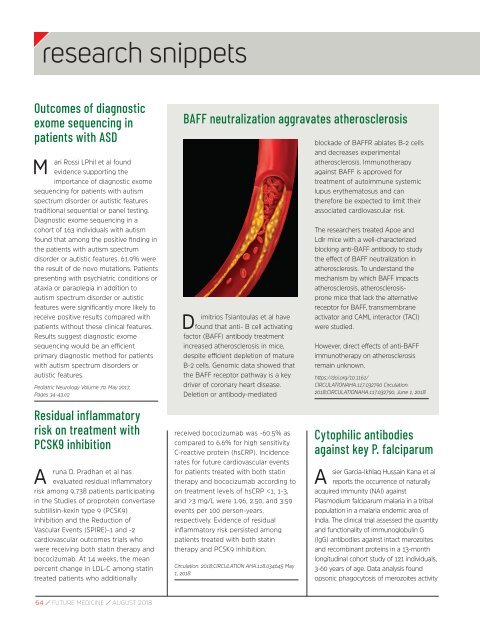FM AUGUST 2018 ISSUE1 - digital edition
You also want an ePaper? Increase the reach of your titles
YUMPU automatically turns print PDFs into web optimized ePapers that Google loves.
esearch snippets<br />
Outcomes of diagnostic<br />
exome sequencing in<br />
patients with ASD<br />
M<br />
ari Rossi LPhil et al found<br />
evidence supporting the<br />
importance of diagnostic exome<br />
sequencing for patients with autism<br />
spectrum disorder or autistic features<br />
traditional sequential or panel testing.<br />
Diagnostic exome sequencing in a<br />
cohort of 163 individuals with autism<br />
found that among the positive finding in<br />
the patients with autism spectrum<br />
disorder or autistic features, 61.9% were<br />
the result of de novo mutations. Patients<br />
presenting with psychiatric conditions or<br />
ataxia or paraplegia in addition to<br />
autism spectrum disorder or autistic<br />
features were significantly more likely to<br />
receive positive results compared with<br />
patients without these clinical features.<br />
Results suggest diagnostic exome<br />
sequencing would be an efficient<br />
primary diagnostic method for patients<br />
with autism spectrum disorders or<br />
autistic features.<br />
Pediatric Neurology Volume 70, May 2017,<br />
Pages 34-43.e2<br />
BAFF neutralization aggravates atherosclerosis<br />
D<br />
imitrios Tsiantoulas et al have<br />
found that anti- B cell activating<br />
factor (BAFF) antibody treatment<br />
increased atherosclerosis in mice,<br />
despite efficient depletion of mature<br />
B-2 cells. Genomic data showed that<br />
the BAFF receptor pathway is a key<br />
driver of coronary heart disease.<br />
Deletion or antibody-mediated<br />
blockade of BAFFR ablates B-2 cells<br />
and decreases experimental<br />
atherosclerosis. Immunotherapy<br />
against BAFF is approved for<br />
treatment of autoimmune systemic<br />
lupus erythematosus and can<br />
therefore be expected to limit their<br />
associated cardiovascular risk.<br />
The researchers treated Apoe and<br />
Ldlr mice with a well-characterized<br />
blocking anti-BAFF antibody to study<br />
the effect of BAFF neutralization in<br />
atherosclerosis. To understand the<br />
mechanism by which BAFF impacts<br />
atherosclerosis, atherosclerosisprone<br />
mice that lack the alternative<br />
receptor for BAFF, transmembrane<br />
activator and CAML interactor (TACI)<br />
were studied.<br />
However, direct effects of anti-BAFF<br />
immunotherapy on atherosclerosis<br />
remain unknown.<br />
https://doi.org/10.1161/<br />
CIRCULATIONAHA.117.032790 Circulation.<br />
<strong>2018</strong>;CIRCULATIONAHA.117.032790, June 1, <strong>2018</strong><br />
Residual inflammatory<br />
risk on treatment with<br />
PCSK9 inhibition<br />
A<br />
runa D. Pradhan et al has<br />
evaluated residual inflammatory<br />
risk among 9,738 patients participating<br />
in the Studies of proprotein convertase<br />
subtilisin-kexin type 9 (PCSK9)<br />
Inhibition and the Reduction of<br />
Vascular Events (SPIRE)-1 and -2<br />
cardiovascular outcomes trials who<br />
were receiving both statin therapy and<br />
bococizumab. At 14 weeks, the mean<br />
percent change in LDL-C among statin<br />
treated patients who additionally<br />
received bococizumab was -60.5% as<br />
compared to 6.6% for high sensitivity<br />
C-reactive protein (hsCRP). Incidence<br />
rates for future cardiovascular events<br />
for patients treated with both statin<br />
therapy and bococizumab according to<br />
on treatment levels of hsCRP 3 mg/L were 1.96, 2.50, and 3.59<br />
events per 100 person-years,<br />
respectively. Evidence of residual<br />
inflammatory risk persisted among<br />
patients treated with both statin<br />
therapy and PCSK9 inhibition.<br />
Circulation. <strong>2018</strong>;CIRCULATION AHA.118.034645 May<br />
1, <strong>2018</strong><br />
Cytophilic antibodies<br />
against key P. falciparum<br />
A<br />
sier Garcia-Ikhlaq Hussain Kana et al<br />
reports the occurrence of naturally<br />
acquired immunity (NAI) against<br />
Plasmodium falciparum malaria in a tribal<br />
population in a malaria endemic area of<br />
India. The clinical trial assessed the quantity<br />
and functionality of immunoglobulin G<br />
(IgG) antibodies against intact merozoites<br />
and recombinant proteins in a 13-month<br />
longitudinal cohort study of 121 individuals,<br />
3-60 years of age. Data analysis found<br />
opsonic phagocytosis of merozoites activity<br />
64 / FUTURE MEDICINE / <strong>AUGUST</strong> <strong>2018</strong>


















